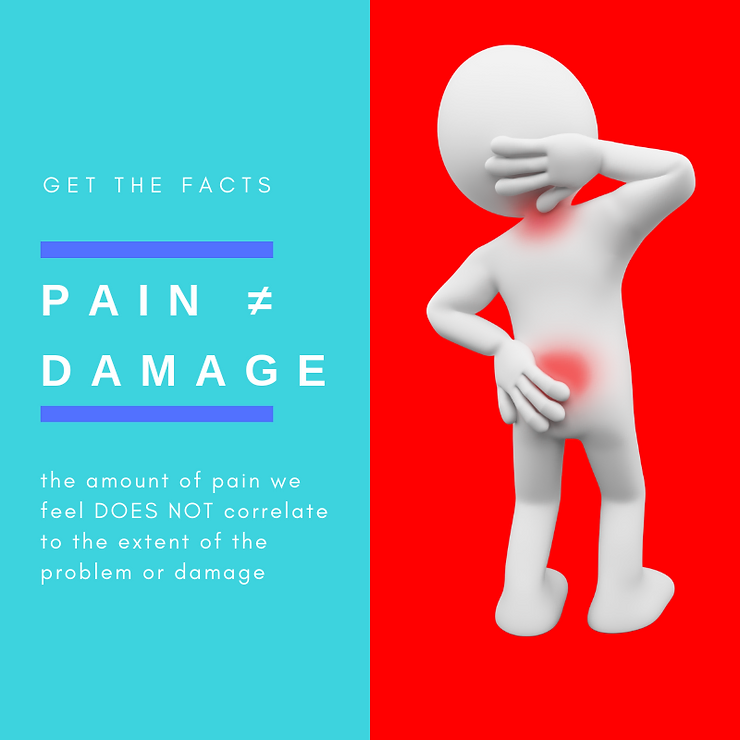Lots of people come to see me because they’re injured in some way.
Sometimes it’s a clear event, they remember the exact moment that changed how they feel, other times it’s not so clear, rather it’s a gradual change over time.
Most injured people follow some familiar pitfalls in their thoughts regarding the injury or pain, so I thought we would take a moment to dispel a common myth about pain.
MYTH #1 – Pain ≠ damage.
Read that again.
Pain DOES NOT mean damage!
Pain is a very basic necessity for life– we’ve villainized this experience, it’s certainly unpleasant, but that’s the point and that doesn’t make it bad! We often think if it hurts then something is wrong but that’s faulty thinking.
Let’s look a little deeper.
Pain is a highly studied experience because science has only scratched the surface of how it works. Pain is an experience in the brain, not in the tissue.
The things that affect pain are so complex that it makes the study of pain science diverse and incredibly expansive.
This is saying: Pain is more than a physical experience.
Pain is now viewed as a “multidimensional, dynamic interaction among physiological, psychological, and social factors that reciprocally influence each other.”
Huh? What’s that even mean?
This means pain doesn’t just come from an injury or illness. It comes from your mind, your environment, and other social factors. These factors have a great deal of influence on your experience.
Pain science is moving forward so quickly that most physicians can’t keep up with emerging science. (Most doctors get only 9-11 hours of education in pain management, that merely .3% of their total curriculum.) If new science emerges, that information takes extensive time before reaching you, the person in pain.
Read on to get the most up-to-date information about pain, and what you can do about it.
To begin, the experience of pain is misleading. Pain is, on its very basis, a danger signal deployed by our brain, not our tissue.
Consider: if someone had a stroke and part of their brain died, that part of their body no longer works. They can’t feel it, they cant use it.
Your brain is in charge.
And its the brain’s job is to protect us from real, and perceived danger. Pain is the most common way to bring that to our attention.
Consider this: when a child fears needles they get really worked up over shots. If the parent encourages the anxiety, this child is nearly inconsolable. They fear for their life and their response matches it. Often, the shot is over before the child realizes it without much pain or damage. The shot itself wasn’t dangerous but their brain has interpreted a dangerous signal and they were working overtime to protect themselves from it.
If pain being “in your head” sounds too new age for you, don’t let that old idea scare you from reading further. Just because the pain is a construct of your brain, doesn’t mean you can just imagine it gone, or that it isn’t real or serious.
Pain is a response sensation produced by your brain. In chronic pain, this sensation is usually over-exaggerated, as the nervous system’s defense system overworks to keep you protected. Thus the response often becomes more severe than the originating cause.
Think of this: If you touched a hot stove, you don’t have to sustain a burn for that experience to be painful. The pain was to prevent future damage and to teach you to be more careful next time.
But you’re thinking: but yeah, I’ve gotten hurt and the pain WAS from damage.
Yes. Getting hurt can cause pain.
But remember, pain isn’t a purely physical experience. Social context matters. Psychology matters.
Now, let’s say your friend had knee pain. They got a knee replacement and had an awful recovery. Now they can no longer golf (insert activity of choice), they don’t have full use and now they’re miserable and depressed.
When you experience knee pain your brain might use that information to protect you from the same fate.
Seems silly, but often brains go into overdrive to protect us and actually give us more pain. It’s your brain’s job to protect you.
We learn by observation, so the things we see and hear influence how our body functions to preserve our quality of life.
Since your life experiences are unique to you, the influences in your pain experience will also be unique.
Both psychology and social context influence how our brain sees the need to protect us.
So, how else do we know that pain doesn’t equal damage?
There’s a growing body of evidence that suggests many diagnoses that are commonly associated with pain occur just as frequently in the “non-injured”.
Take for example this study where healthy participants received an MRI of their spine. 52% were diagnosed with a herniated disc, in at least one level of their spine, though they were asymptomatic. (Disc herniations are worthy of their own post, we’ll cover that another day)
Disc herniations, like the ones cited in this study, which are confirmed by MRI, are often prescribed surgery to correct. Here we can see these patients had no symptoms, so why would we “correct” it?
It leads to the question when you get that MRI and it shows a herniation, who’s to argue how long that herniation existed before the pain began, or that it’s the cause of your current experience?
Not enough to make you question the origin of your pain experience?
Here’s another study done on shoulders found that pain was not an indicator of tear severity.
For many orthopedic disorders, pain is used as an indicator of damage severity or the need for surgical repair but the pain is a complex experience that has more effects than just tissue damage.
Even the combination of pain AND tear doesn’t always indicate that surgery is the best treatment method – surgery doesn’t correlate to decreased pain, it just that something has been “fixed”. (There are many placebo factors that make a surgery successful, check out this article where similar results were achieved between a control and placebo group, despite one group receiving no surgery at all!)
Many doctors recognize the number of “failed surgeries”, those surgeries which repair a ligament or tendon but the patient still presents with movement limitations and pain post-surgical intervention, and now recommend a more conservative approach.
If we image healthy individuals without pain and they present with the same diagnosis, as you who feel crippled with unimaginable pain levels, what’s the difference? If you have so much pain that you’re having a hard time moving, how do we treat it? That’s what pain scientists are working on.
To start treating pain, we have to think about the purpose of pain: to alert you of damage OR the potential of damage. Ever touch a hot stove? It hurts! Most times, you pull your hand away before you receive a full burn from it. Paper cuts and stubbed toes can bring tears to a grown man’s eyes, but usually don’t cause damage. Pain can be just the alert of a threat. Think about it, how long could you live if your body didn’t alert you of potential harm? Not long.
In absolutely no way am I saying that you’re some kind of hypochondriac whose suffering a mental disorder, I AM saying that pain is complex and multifactorial. Often, pain is out of proportion to the problem. Imaging can’t analyze how threatening an injury is to your well-being and isn’t a good indicator of your experience. So relax, I know it hurts but running and getting it imaged isn’t always your best move.
If you have more questions, please reach out. I can send your articles, refer you to other healthcare practitioners or even introduce you to support groups.
Kristin
Want to read more?
Because almost no one over the age of 40 is going to have a normal knee or shoulder MRI.
MRI and X-Rays are almost useless for back pain
“For back pain, MRI and X-ray are medical machines that make false alarms.”
Pain Recovery Strategies by Dr. Greg Lehman <if you’re dealing with pain, download this FREE workbook!!!!>

